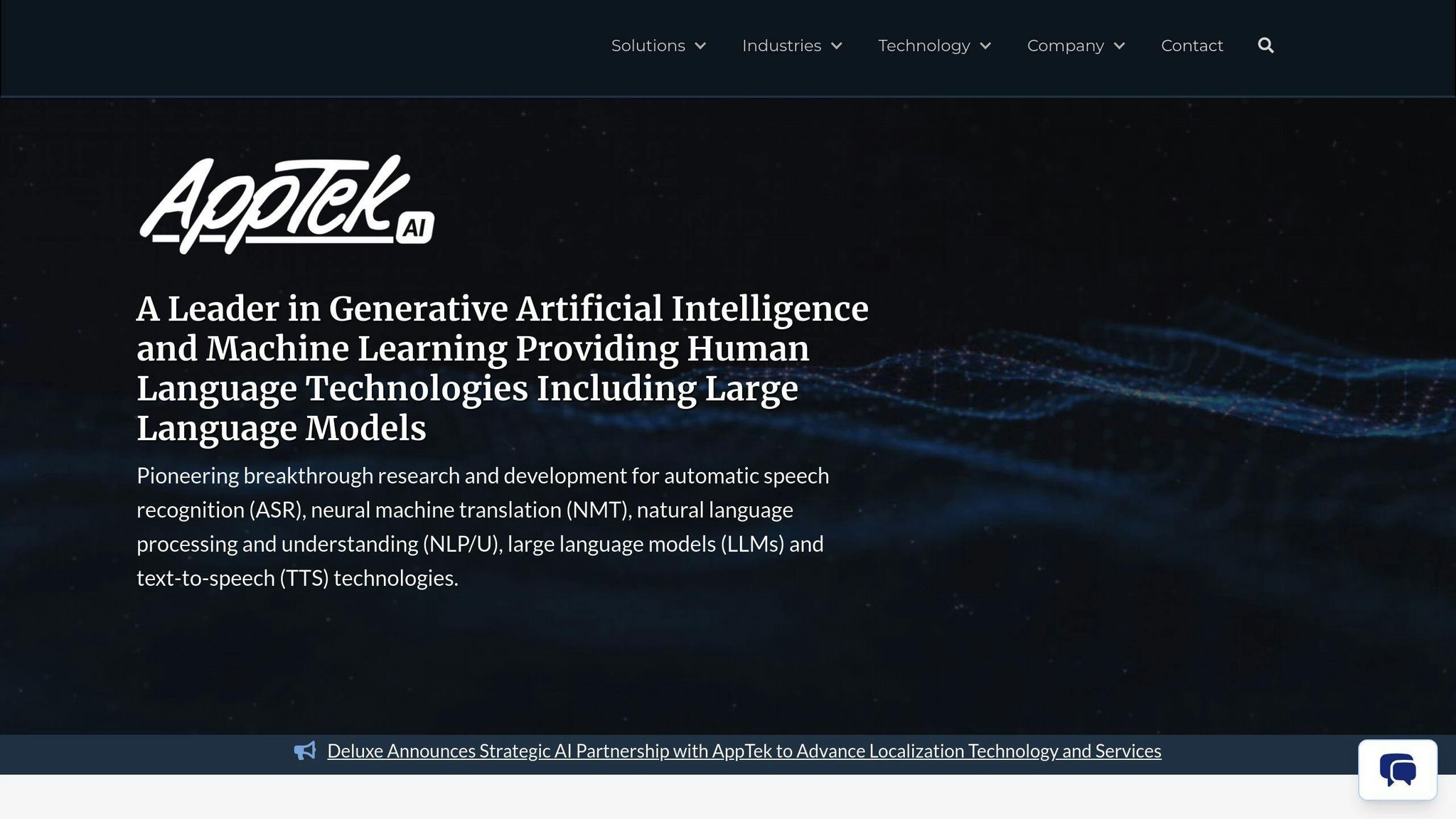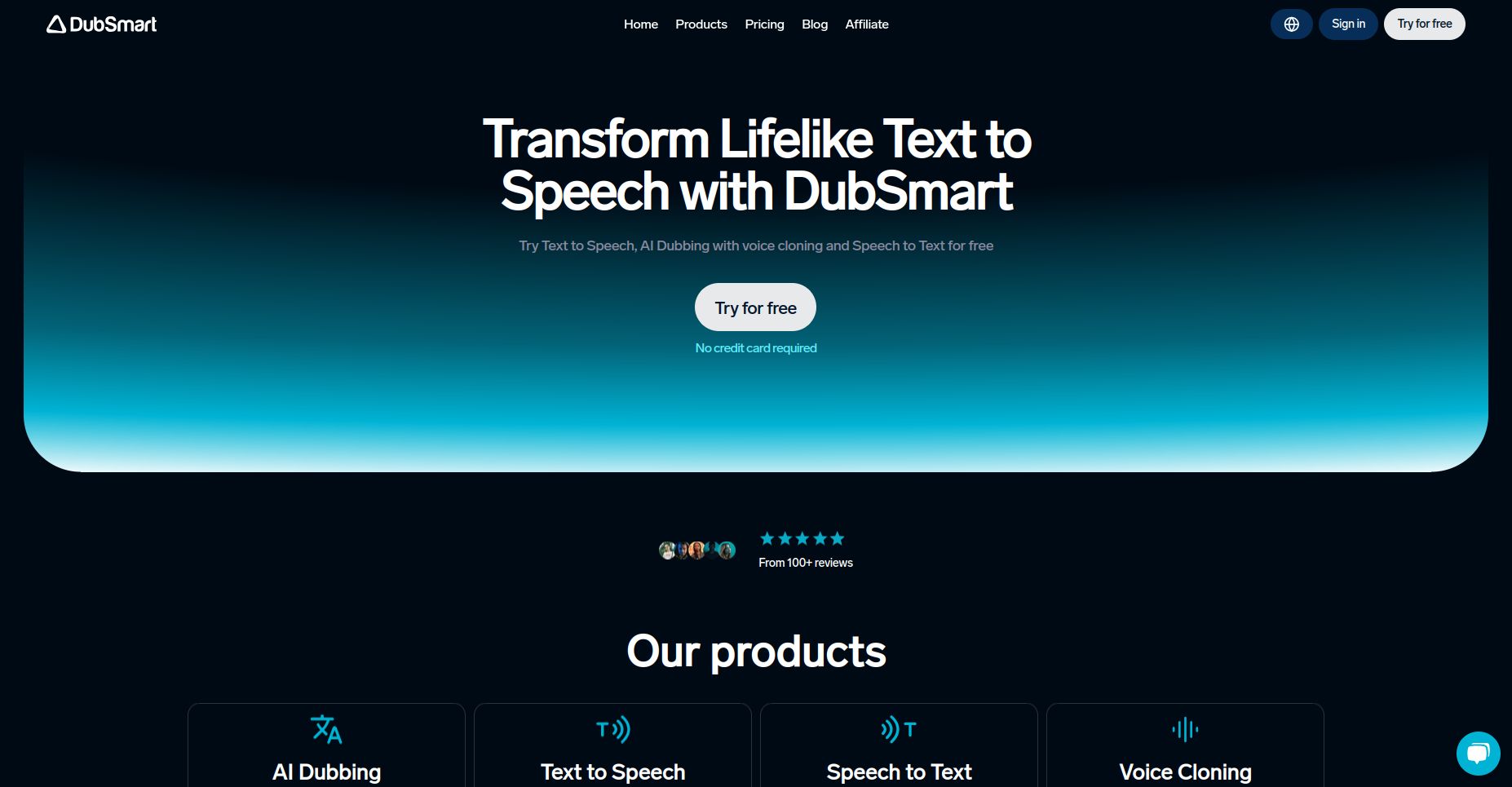AI Speech Models for Subtitle Accuracy
Accurate subtitles are essential for accessibility and global content sharing. AI speech models like AppTek, Google ASR, OpenAI Whisper, and DubSmart are transforming subtitle generation, each excelling in specific areas:
- AppTek ASR: Best for handling accents in live broadcasts (90%+ accuracy).
- Google ASR: Supports 120+ languages with real-time cloud integration (96-97% accuracy).
- OpenAI Whisper: Excels in noisy environments using advanced noise resilience.
- DubSmart: Tailored for studio workflows with voice cloning and precise timing.
Quick Comparison:
| Model | Key Strength | Accuracy | Language Support | Ideal Use Case |
|---|---|---|---|---|
| AppTek ASR | Accent handling | 90%+ | 50+ | Live broadcasting |
| Google ASR | Broad language support | 96-97% | 120+ | Multilingual content |
| OpenAI Whisper | Noise resilience | High | 100+ | Noisy environments |
| DubSmart | Studio-grade precision | High | 33 | Studio production |
Choose the model based on your needs: live subtitles, multilingual content, noisy audio, or professional production.
1. AppTek's ASR System

AppTek's ASR System addresses the challenges of real-time subtitles by using advanced techniques like noise reduction and accent normalization. It achieves over 90% accuracy in optimal conditions, making it a strong contender in live broadcast solutions. This sets it apart from Google's cloud-based approach, which will be discussed later.
To evaluate performance, AppTek uses the SubER metric (Subtitle Edit Rate), created in collaboration with Athena Consultancy.
"SubER represents a significant advancement in the evaluation of automatic subtitle quality. By focusing on the edits needed to align machine-generated subtitles with a professionally created reference set, it provides a more nuanced and user-focused measure of subtitle accuracy than traditional automated metrics." - AppTek and Athena Consultancy, 2022 IWSLT conference
Three key features contribute to the system's effectiveness:
| Feature | Capability | Impact |
|---|---|---|
| Real-time Processing | Generates subtitles alongside audio | Supports live broadcasts with precision |
| Noise Management | Uses advanced filtering algorithms | Maintains accuracy in noisy environments |
| Accent Handling | Normalizes accents through machine learning | Improves support for multilingual content |
With its ability to process live audio and generate synchronized subtitles, this system is a strong choice for broadcasts that demand real-time accuracy.
2. Google's ASR Technology
Google's ASR Technology plays a major role in real-time subtitle generation, delivering 96-97% accuracy under ideal conditions.
With support for over 100 languages and automatic detection, the system tackles the challenge of accent and dialect diversity, making multilingual subtitling more accessible.
| Feature | Capability | Performance Impact |
|---|---|---|
| Language Support | Covers 100+ languages | Expands global content accessibility |
| Live Adaptation | Adjusts to audio changes | Keeps latency under 500ms |
| Accent Handling | ML-based normalization | Enhances accessibility for dialects |
Building on AppTek's focus on live broadcasts, Google's system aims for broader reach, particularly through YouTube's auto-caption feature, which processes millions of videos every day.
"Google's ASR Technology represents a significant advancement in handling diverse linguistic contexts. However, it can face challenges with very low-quality audio or technical jargon, highlighting areas where further development is needed." - Speech Recognition Technology Review, 2024
Google strengthens its real-time processing with advanced dialect models. While AppTek excels in live broadcasting, Google's edge lies in managing accents and adapting to different environments across multiple platforms and formats.
3. OpenAI's Whisper
OpenAI's Whisper stands out for its ability to handle tough audio scenarios where many traditional ASR systems fall short. Inspired by Google's multilingual design, Whisper takes it a step further by incorporating a transformer architecture that boosts its ability to manage noisy environments.
This transformer architecture tackles two key challenges: processing long-range speech patterns and delivering accurate subtitles even in audio with heavy noise or varied accents. Whisper achieves this by training on an impressive dataset of 680,000 hours of multilingual audio.
| Feature | Capability | Application |
|---|---|---|
| Noise Resilience | Advanced filtering | Manages noisy audio effectively |
| Accent Recognition | Multi-dialect support | Accurate transcription for diverse accents |
| Real-time Processing | Low-latency output | Ideal for live subtitles |
| Language Coverage | Broad multilingual support | Accessibility for global audiences |
Unlike earlier solutions that focus on platform reach (like Google) or precision in broadcasting (like AppTek), Whisper shines in its ability to manage complex and noisy audio environments.
"Despite its strengths, Whisper may struggle with very rare languages or severely degraded audio. Addressing these challenges through further training and data enrichment is essential for its continued improvement." - Speech Recognition Technology Review, 2024
To achieve the best results, experts suggest pairing Whisper with human reviewers, especially for projects requiring near-perfect accuracy. It's also worth noting that the model performs best with dedicated GPU resources for real-time tasks.
sbb-itb-f4517a0
4. DubSmart

DubSmart stands out by focusing on integrating seamlessly into creator workflows. Unlike other models that prioritize technical accuracy metrics, DubSmart uses voice cloning-informed speech recognition across 33 languages to streamline the process. Its parallel processing architecture ensures frame-accurate synchronization with delays under 300ms, making it highly effective for multilingual content production.
This system shines in handling technical content where precise terminology and timing are critical. It tackles key accuracy issues that often challenge other models, particularly in professional production settings.
| Feature | Implementation | Benefit |
|---|---|---|
| Language Support | 33 languages for subtitles | Enables global content sharing |
| Processing Speed | Real-time generation | Ideal for live subtitling |
| Voice Recognition | Multi-speaker detection | Handles complex dialogue |
| Output Format | Multiple subtitle formats | Works across various platforms |
DubSmart places a strong emphasis on maintaining context across languages while ensuring precise timing. Its subtitle generation system performs exceptionally well with studio-grade audio inputs, leveraging its parallel audio processing to achieve high accuracy.
One key feature is its automated speech-to-text transcription system. This capability enhances subtitle timing and manages complex audio scenarios, such as multi-speaker environments, with greater precision.
Strengths and Weaknesses
Each AI speech model brings its own set of strengths and limitations when it comes to subtitle generation, based on the technical features discussed earlier.
Core Performance Features
| Feature | AppTek ASR | Google ASR | OpenAI Whisper | DubSmart |
|---|---|---|---|---|
| Key Differentiator | Accent Handling | Cloud Integration | Noise Resilience | Production Focus |
| Real-time Processing | Broadcast-grade | Cloud-optimized | GPU-dependent | Frame-accurate |
| Noise Handling | Moderate | Adaptive | Best-in-class | Studio-grade |
| Language Support | 50+ | 120+ | 100+ | 33 |
| Speaker Detection | Basic | Advanced | Advanced | Multi-speaker |
| Integration Options | Limited | Extensive | Open-source | Workflow-focused |
AppTek ASR stands out for its ability to handle various accents and speech patterns, making it a reliable choice for international content. However, it struggles in environments with heavy background noise.
Google ASR offers the broadest language support and seamless integration with its cloud ecosystem. That said, its reliance on stable internet connectivity can be a drawback in certain scenarios.
OpenAI Whisper is designed to thrive in noisy conditions, thanks to its robust noise-handling capabilities. However, its real-time performance can be limited by its dependency on high-powered GPUs.
DubSmart is tailored for production environments, offering tools like voice cloning and advanced multi-speaker detection. Its focus on studio workflows makes it less versatile for general use.
These distinctions make it clear that the choice of model often depends on specific deployment needs. For example, VLC's CES 2025 presentation highlighted the importance of offline processing, underlining how operational requirements can influence model selection.
Wrapping Up
Our look at four different approaches highlights clear specialization trends. Each solution tackles one of the main challenges - accent handling, timing alignment, noise reduction, and format compliance - using distinct technical methods.
The SubER metric plays a crucial role in measuring progress, helping narrow the 3% accuracy gap between AI and traditional methods. It evaluates both text accuracy and timing precision, which are critical for practical applications.
For global accessibility, Google's ASR Technology stands out with its broad language support and cloud integration. Meanwhile, AppTek's ASR System shines in professional subtitling, especially for international content where managing accents is critical.
Here’s how to choose the right model based on your needs:
| Use Case | Recommended Model | Key Advantage |
|---|---|---|
| Live Broadcasting | Google ASR | Real-time processing |
| Studio Production | DubSmart | Frame-accurate timing |
| Noisy Environments | OpenAI Whisper | Superior noise handling |
| International Content | AppTek ASR | Accent adaptation |
